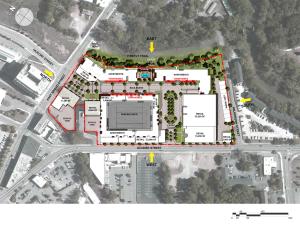Christmas Comes Early for Downtown
'Tis the Season for Selig's New Plans—Minus Walmart

Photo Credit: Niles Bolton Associates
A rendering of the proposed development looking south on East Broad Street.
When Bob Googe, CEO of the Athens-based coffee chain Jittery Joe's, met with representatives from Selig Enterprises recently to discuss new plans for a controversial mixed-use development on the edge of downtown Athens, he told them: "I think your opposition just disappeared."
It hasn't completely evaporated—some residents remain wary of Selig's intentions—but it has certainly dried up since the Atlanta developer released the new plans last week. Athenians banded together to fight the massive development at the former Armstrong & Dobbs property—which at the time included the hated Walmart as the anchor tenant—in a way they hadn't since the Classic Center clash 20 years ago. And they won. "There will no longer be a Walmart," Selig Senior Vice President Jo Ann Chitty pronounced Dec. 12.
"It sounds cheesy, but I'm proud of Athenians stepping up and saying what they want to see on that property," says Russell Edwards, who formed the group People For a Better Athens a year ago to fight a downtown Walmart.
No Walmart, But No Grocery

A map of the proposed development.
Selig's latest plans for the nine-acre tract between Oconee, East Broad and Wilkerson streets incorporate many of the criticisms the company heard about its initial 2011 proposal. For one, there's no big box. The 95,000 square-foot anchor store that Walmart would have occupied is now 35,000 square feet, about the size of a small grocery store like Earth Fare or Bell's.
Walmart pulled out because experiments with urban markets that are smaller than supercenters and emphasize groceries haven't gone well, according to Chitty. "It wasn't specifically about Athens," she says. "There was a corporate decision to suspend that because the stores weren't performing the way they wanted them to."
Unfortunately, the development will not include a long-awaited downtown grocery store. Chitty said she talked to every grocery chain in the country, but the cost of a parking deck drove up rents too high for the low-margin sector, and architects had trouble finding space for a loading dock. It remains to be seen who will come into that space, or others that make up the development's 125,000 square feet of commercial space—two-thirds the size of the initial proposal. "No one knows who the tenant or tenants might be for that space, but it has the potential to be something very, very special,"Chitty says.
The tenants are likely to be a mix of local businesses and national retail chains like The Gap, says Jack Crowley, the University of Georgia College of Environment and Design professor who is overseeing a master plan for downtown. As for a grocery store, downtown still needs a larger population to support one, as well as solutions to problems like state blue laws and where to unload stock, he says. "It's not going to happen for a while," he says.
Mayor Nancy Denson pushed for the original big-box design in part because she wanted a grocery store. "I still think that's something that would have been good for downtown—having a grocery store or a smaller-sized Walmart, someplace to buy the essentials," she says. Nevertheless, Denson says the new plans are "amazingly improved" over the first version. "I'm just delighted that it's a go, because we need the tax base; we need the jobs in the community," she says.
Among downtown business owners who had felt threatened by the new development, reaction ranged from relief that Walmart ditched the project to cautious optimism to continued skepticism about what adding so much new retail space will do to downtown's historic core.
Frontier owner Devin Clower says she's happy about many of the changes Selig has made, but she still questions whether downtown needs so much new commercial space. Hopefully, all of the new residents who will be moving into several new downtown developments will create enough business for everyone, she says. "I just don't want to see empty space," she says.

A rendering of the proposed development looking north on Oconee Street.
Sanni Baumgärtner, who owns Community, says she is "relieved and happy to hear that Walmart will not come downtown" but still opposes the development. She compares it to the West Washington Street parking deck that opened earlier this year with an all-chain roster of restaurants on the ground floor. Downtown should develop "organically," rather than at the hands of a big out-of-town developer, she says. "We are still facing a huge new development right next to our thriving downtown that will threaten our locally owned businesses," Baumgärtner says.
More development downtown will create a critical mass that will benefit everyone, Chitty says. "From a retail perspective, having more people downtown is a positive."
Crowley agrees that, instead of competing with existing businesses, new development should benefit them. He notes that $250 million in new construction containing about 1,700 beds within easy walking distance of downtown is on the horizon, including 250 units in the Selig development. "That's 1,700 new shoppers and revelers," he says.
Take Me to the River
For many critics, Walmart was the main issue. Others pointed to the development's design, which in its original form focused inward, with a parking deck facing Firefly Trail, a future rails-to-trails project, and its back turned to the North Oconee River. The new design features residential units facing the trail that will one day run along the back side of the property, with a connection from the trail into the development.
"I think that's going to be a real amenity and a draw for hikers, as well as the people moving in there," Athens-Clarke Commissioner Kelly Girtz says.

A view of the site from Oconee Street.
Clower wants the Selig development to be an extension of downtown. "One of my biggest interests is connecting downtown to the river," she says. "There's so much potential there. I hope it's not cutting everything off."
It won't, Crowley says. "I think it could be a massive link from downtown to the river area—'massive' meaning a very, very effective one," he says.
Not everyone is so sure. "I find it every telling that two of the more problematic elements of the last plan are not included in the materials released [last] week," says Tony Eubanks, co-founder of Protect Downtown Athens, a group that focused on flaws in Selig's design, rather than Walmart. Eubanks says he's waiting to see images showing the Firefly Trail and Wilkerson Street sides of the development before weighing in on the new plans.
Athens-Clarke County's zoning code calls for ground-floor commercial space in residential buildings, so Selig will have to seek a variance from the county government—one it seems likely to get at this point. Girtz says he's fine with ground-floor residential along the trail because the project includes a good mix of retail and commercial, while Denson says she thinks it makes the project better.
But the process will be a long one. Chitty says she intends to file for the variance in February. County officials would then review it, sending it on to the Planning Commission to make a recommendation to the county commission. The process is expected to take about four months, says Selig spokesman Brian Brodrick of the public relations firm Jackson-Spalding, putting the start of the 18-month construction period at mid-2013. This will be the first time planners have seen anything from Selig on paper, and they'll have a lot to look at, Athens-Clarke Senior Planner Bruce Lonnee says, but he expects the process to go relatively smoothly.
"You would think, with the amount of engagement, they'd have thought through the answers to the things that had people concerned," Lonnee says.
Jittery No's
There is at least one objection to the project that Selig has no answers to, though—the fate of Jittery Joe's Roasting Co. and the warehouse ruins on the property that the company is tearing down. "It's extremely disappointing that they still intend to bulldoze the historic warehouses," activist Melissa Link says. "Especially Jittery Joe's, which is a stunning example of adaptive reuse that incorporates the talents of our local creative community in a building that is essentially an icon of the funky vibe that defines Athens for so much of the outside world." Link says she'd rather see the architects incorporate those stone and brick walls into new structures that acknowledge the property's history. (See Athens Rising on p. 7 for more on that topic.)

Chitty, the Selig VP, maintains there was no way to develop the property without razing those buildings. While Girtz—the commissioner who used a local preservation law to put a hold on Selig's demolition permit a year ago—would like the developer to keep those buildings, it's not a deal-breaker for him. "There's give and take with every project," he says.
Googe, the Jittery Joe's CEO, calls the design "spectacularly better than their first plan." And it's possible the roasting company might find a home in the new development. "We're very optimistic they will have a place in the project," Chitty says. The roaster may not fit in among the development's retailers and restaurants, and leasing space there may be too expensive, Googe says, but he'd like to keep it as close to downtown as possible.
"We're communicating" with Selig, he says. "We're talking about what will work, what won't work, so we don't know what will happen yet."
Questions also remain about traffic and parking. Unlike the original plans, the new version includes Hickory Street Extension, a planned street that would run from East Broad Street at the Multimodal Transportation Center through the Armstrong & Dobbs property to Oconee Street, creating a flat connection between the bus station and the UGA campus. The street will include two travel lanes that can accommodate buses, parallel parking, bike lanes and sidewalks.
The intersection of the unnamed new "boulevard" and Oconee Street will have a traffic signal, and Oconee Street, which is just one lane running southeast, will get a turn lane for shoppers coming to the development from Broad Street, Chitty says. Selig will submit a traffic study to ACC as part of its variance application.
Once drivers get there, they can park in a hidden 700-space deck inside a retail and residential building fronting Oconee Street. Will the deck compete with ACC-owned decks downtown? "We haven't really worked what the parking rates would be," Chitty says.
In spite of such lingering questions and concerns, most people rate Selig's second effort as a vast improvement over the 2011 Walmart-centric plan that sparked such an outcry. "I think it's a big improvement," says Edwards, the People For a Better Athens leader. "Anyone would say that, I think."












comments